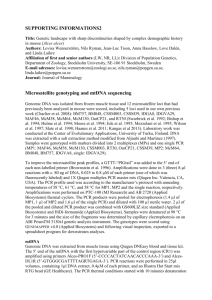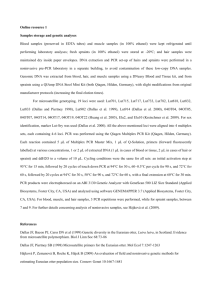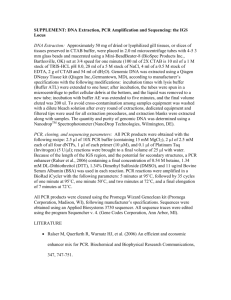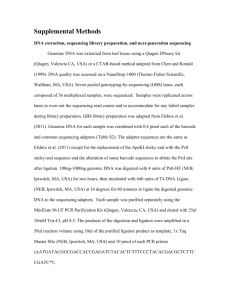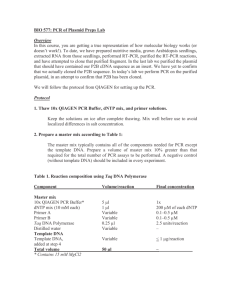MEC_4791_sm_AppS1
advertisement
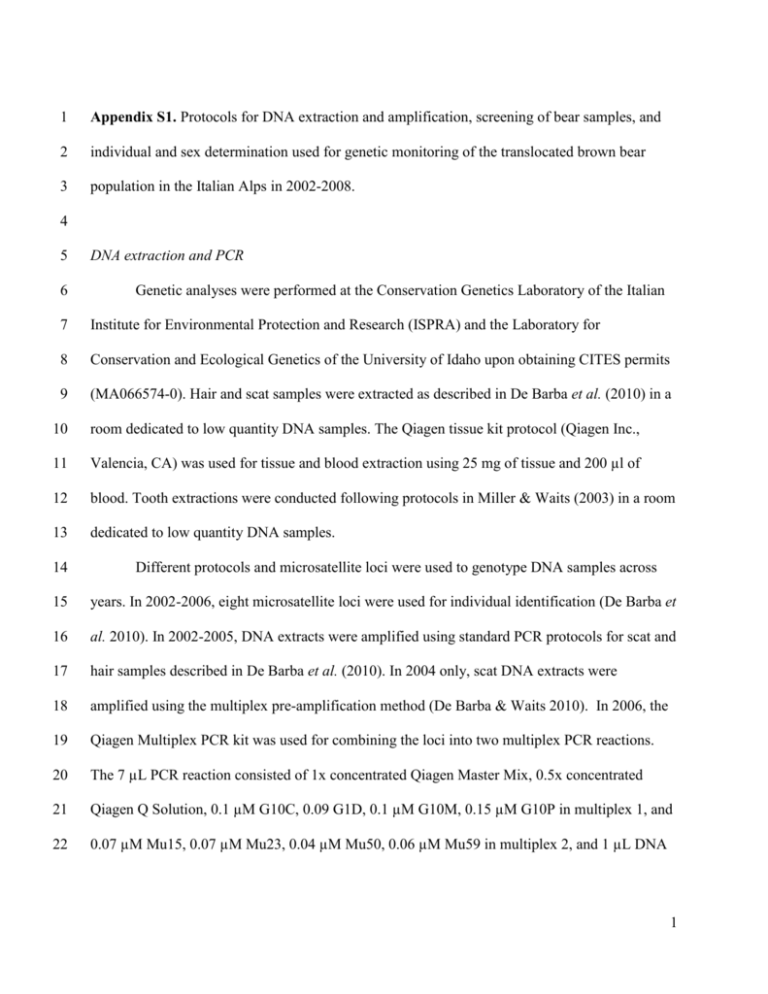
1 Appendix S1. Protocols for DNA extraction and amplification, screening of bear samples, and 2 individual and sex determination used for genetic monitoring of the translocated brown bear 3 population in the Italian Alps in 2002-2008. 4 5 6 DNA extraction and PCR Genetic analyses were performed at the Conservation Genetics Laboratory of the Italian 7 Institute for Environmental Protection and Research (ISPRA) and the Laboratory for 8 Conservation and Ecological Genetics of the University of Idaho upon obtaining CITES permits 9 (MA066574-0). Hair and scat samples were extracted as described in De Barba et al. (2010) in a 10 room dedicated to low quantity DNA samples. The Qiagen tissue kit protocol (Qiagen Inc., 11 Valencia, CA) was used for tissue and blood extraction using 25 mg of tissue and 200 µl of 12 blood. Tooth extractions were conducted following protocols in Miller & Waits (2003) in a room 13 dedicated to low quantity DNA samples. 14 Different protocols and microsatellite loci were used to genotype DNA samples across 15 years. In 2002-2006, eight microsatellite loci were used for individual identification (De Barba et 16 al. 2010). In 2002-2005, DNA extracts were amplified using standard PCR protocols for scat and 17 hair samples described in De Barba et al. (2010). In 2004 only, scat DNA extracts were 18 amplified using the multiplex pre-amplification method (De Barba & Waits 2010). In 2006, the 19 Qiagen Multiplex PCR kit was used for combining the loci into two multiplex PCR reactions. 20 The 7 µL PCR reaction consisted of 1x concentrated Qiagen Master Mix, 0.5x concentrated 21 Qiagen Q Solution, 0.1 µM G10C, 0.09 G1D, 0.1 µM G10M, 0.15 µM G10P in multiplex 1, and 22 0.07 µM Mu15, 0.07 µM Mu23, 0.04 µM Mu50, 0.06 µM Mu59 in multiplex 2, and 1 µL DNA 1 23 extract for hair and 2 µL DNA extract for scat. The PCR profile had an initial denaturation step 24 of 15 minutes at 94°C followed by a touchdown with 12 cycles of 30 seconds at 94°C, 90 25 seconds at 57.3°C with a decrease in annealing temperature by 0.4°C each cycle, and 1 minute at 26 72°C followed by 27 cycles of 30 seconds at 94°C, 90 seconds at 52.5°C, 1 minute at 72°C and a 27 final elongation at 60°C for 30 min. A PCR negative was included in each group of reactions to 28 test for contamination. PCR products from each multiplex were added to 10 µl mix of formamide 29 and ROX350 size standard (Applied Biosystems) (10:0.26 µl) and run in two separate capillaries 30 on the Applied Biosystems 3130xl ABI capillary machine. PCR products were scored using 31 Genemapper3.7 software (Applied Biosystems). In 2007, G10C and G10M were replaced with 32 CXX20 (Ostrander et al. 1993) and Mu11 (Taberlet et al. 1997) and in 2008, Mu23 was replaced 33 with G10M. PCR protocols and profiles were the same as in 2006 except adjusting the 34 multiplexes for 0.15 µM CXX20 and 0.06 µM Mu11. In addition, a panel of ten loci (all of the 35 above except that G10C was substituted with 0.08 µM G10X – Taberlet et al. 1997) was used for 36 confirming all unique genotypes identified since the beginning of the project using two samples 37 per genotype when available. 38 Molecular sexing was performed using the Amelogenin locus (Ennis & Gallagher 1994) 39 as described in Robinson et al. (2007). To screen for brown bear samples among samples that 40 failed microsatellite genotyping, a 150 bp segment of mitochondrial DNA (mtDNA) control 41 region was amplified as described in Murphy et al. (2000) and separated by size on an 42 ABI3130xl. 43 44 2 45 46 Protocol for individual identification and sex determination In 2002-2004 we established a standardized data analysis protocol for individual ID 47 assuring reliable genotyping and assigning genotypes to samples based on a reference genotype 48 approach (De Barba et al. 2010). This protocol allowed us to accept a genotype after one PCR 49 for hair samples when the genotype matched a known genotype, and after observing an allele in 50 at least two PCRs for scat samples. The data analysis protocol used in the following years was 51 the same, except that i) in 2006-2008 the initial screening of sample quality was done by 52 performing 2 multiplexes (8 loci); ii) in 2006-2008 samples were kept for further analyses if they 53 had scorable results at ≥ 50% loci; iii) six loci were sufficient to unambiguously identify a 54 genotype in 2005, and seven in 2006-2008; iv) in 2007-2008 a ten locus genotype was generated 55 for each unique genotype sampled; v) the location of genotyped samples was checked against 56 field data and knowledge of bears’ distribution gained in previous years of sampling. In each 57 year we required that the PID(sib) (Waits et al. 2001) was lower than the threshold established 58 considering the number of first-order relatives in the population (De Barba et al. 2010). The 59 threshold ranged from 0.048 (2002) to 0.0028 (2008). Error rate due to allelic dropout and false 60 alleles was estimated following the approach of Broquet & Petit (2004). In 2002 error rate was 61 not calculated due to the low number (< 10) of samples genotyped from scat and faecal samples. 62 In 2003-2004 all genotyped samples and PCRs performed were used for calculations. In 2005- 63 2008 the first PCR and either all (when < 40) genotyped samples or 40 randomly selected from 64 each sampling method were used. Only newly identified genotypes were processed for sex ID 65 and were replicated a minimum of three times. Known samples were used as positive controls in 66 each sex ID PCR reaction, and when possible, more than one sample from the same individual 3 67 was included. Error rate of molecular sexing was estimated on all samples using the first PCR 68 performed. 69 70 Literature cited 71 Broquet T, Petit E (2004) Quantifying genotyping errors in noninvasive population genetics. 72 73 74 75 Molecular Ecology 13, 3601-3608. De Barba M, Waits LP (2010) Multiplex pre-amplification for noninvasive genetic sampling: is the extra effort worth it? Molecular Ecology Resources 10, 659-665. De Barba M, Waits PL, Genovesi P, et al. (2010) Comparing opportunistic and systematic 76 sampling methods for non-invasive genetic monitoring of a small translocated brown 77 bear population. Journal of Applied Ecology 47, 172-181. 78 79 80 Ennis S, Gallagher TF (1994) A PCR-based sex-determination assay in cattle based on the bovine amelogenin locus. Animal Genetics 25, 425-427. Miller CR, Waits LP (2003) The history of effective population size and genetic diversity in the 81 Yellowstone grizzly (Ursus arctos): Implications for conservation. Proceedings of the 82 National Academy of Sciences of the United States of America 100, 4334-4339. 83 Murphy MA, Waits LP, Kendall KC (2000) Quantitative evaluation of fecal drying methods for 84 brown bear DNA analysis. Wildlife Society Bulletin 28, 951-957. 85 Ostrander EA, Sprague GF, Rine J (1993) Identification nad characterization of dinucleotide 86 repeat (CA) in markers for genetic mapping in dogs. Genomics 16, 207-213. 4 87 Robinson S, Waits LP, Martin ID (2007) Evaluating population structure of black bears on the 88 Kenai Peninsula using mitochondrial and nuclear DNA analyses. Journal of Mammology 89 88, 1288-1299. 90 91 Taberlet P, Camarra JJ, Griffin S, et al. (1997) Non-invasive genetic tracking of the endangered Pyrenean brown bear population. Molecular Ecology 6, 869-876. 92 Waits LP, Luikart G, Taberlet P (2001) Estimating the probability of identity among genotypes 93 in natural populations: cautions and guidelines. Molecular Ecology 10, 249-256. 94 95 96 5




